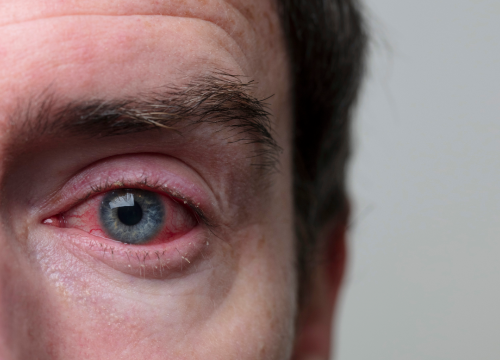Difference Between Hordeolum and Chalazion and Blepharitis
A hordeolum is an infected oil gland that develops on the eyelid. A chalazion is a bump that forms due to a clogged oil gland. Blepharitis is the accumulation of skin debris and bacteria below the eyelashes.

What is a Hordeolum?
Definition:
A hordeolum is also known as a stye, and it is when an oil gland on the eyelid gets infected.
Causes and prevalence:
The most common reason for developing a hordeolum is that Staphylococcus aureus bacteria affect an oil gland (meibomian) on the eyelid; usually it is also associated with an eyelash follicle. The S. aureus bacteria is thought to be the cause of stye in 95% of cases. This condition tends to be more common among adults than children.
Symptoms and complications:
The signs that you have a stye include the development of a swollen bump on an eyelid. The bump will be swollen, red, and very painful. The patient often feels like there is something in their eye. Although it is uncommon, orbital cellulitis can develop as a complication of a hordeolum.
Diagnosis:
A visit to an eye doctor is the best way to diagnose a hordeolum. The doctor will take the patient’s history and examine the eye and eyelids.
Treatment:
Oral antibiotics are often used to treat stye. The other treatment option is to place a hot compress over the affected eye and eyelid.

What is a Chalazion?
Definition:
A chalazion is defined as a bump on the eyelid that develops when an oil gland is blocked.
Causes and prevalence:
A chalazion develops when an oil gland becomes blocked, and it can also occur due to blepharitis or certain skin conditions like rosacea or seborrheic dermatitis. It occurs most often in people aged between 30 and 50.
Symptoms and complications:
With a chalazion, a bump develops on the eyelid. This is not normally painful but may irritate the eye if it is large. Several complications can occur including preseptal cellulitis.
Diagnosis:
Diagnosis is best done by an eye doctor who examines the eye and surrounding structures.
Treatment:
Hot compresses placed on the eye with the chalazion can be helpful. If the chalazion is big, you may need a doctor to drain it. Steroids may also be used to help reduce swelling and inflammation.

What is Blepharitis
Definition:
Blepharitis is when inflammation occurs at the bottom of the eyelashes.
Causes and prevalence:
The cause of blepharitis is an accumulation of bits of skin and bacteria. This is a common condition with at least 80 million people in the U.S. thought to have blepharitis.
Symptoms and complications:
The eyelids feel swollen and appear red. The eye itself feels itchy and is red. The person may complain of dry eyes and a burning sensation in the eyes. Blepharitis can develop into a chalazion.
Diagnosis:
Blepharitis is normally diagnosed during an eye exam where a slit-lamp exam is done. In some cases, the doctor may take a swab of the material to test for bacteria.
Treatment:
Treatment consists of warm compresses and corticosteroids. Antibiotic ointments may be needed for acute cases of blepharitis.
Difference between Hordeolum and Chalazion and Blepharitis?
Definition
A hordeolum is a swollen area on the eyelid due to infection of an oil gland. A chalazion is also a swollen area on the eyelid, but is due to a blocked oil gland. Blepharitis is a buildup of bacteria and skin flakes at the base of the eyelashes.
Location
A hordeolum is located outside of the eyelid while a chalazion is on the inside of the eyelid. Blepharitis is found at the base of the eyelashes.
Infected
There is infection in the case of a hordeolum. A chalazion is not an infected area, while in the case of blepharitis, there may or may not be infection.
Symptoms
In the case of a hordeolum, a red, swollen, and painful bump develops on an eyelid. In the case of a chalazion, a red and swollen bump also develops on an eyelid. In the case of blepharitis, the eyes feel itchy and burning, and may also be red and swollen.
Complications
A complication of a hordeolum is orbital cellulitis. Chalazion complications include deformities of the eyelid, hordeolum, and preseptal cellulitis. Blepharitis complications include dry eyes, increased tear production, pink eye, and chalazion.
Table comparing Hordeolum and Chalazion and Blepharitis

Summary of Hordeolum Vs. Chalazion Vs. Blepharitis
- A hordeolum and chalazion are both bumps that develop on the eyelids.
- Blepharitis is an inflammatory reaction due to a crust that forms below the eyelashes.
- A hordeolum, chalazion, and blepharitis are conditions that should be treated to prevent complications.
FAQ
What is the difference between blepharitis and hordeolum?
Blepharitis is inflammation of the region below the eyelashes while hordeolum is a stye on the eyelid.
What is the difference between chalazion and blepharitis?
A chalazion is a bump on the eyelid while blepharitis is a buildup of material below the eyelashes.
How can you tell the difference between a chalazion and a hordeolum?
A hordeolum is more painful and often filled with pus, while a chalazion is not painful and does not have pus.
Can blepharitis cause hordeolum?
Blepharitis can lead to the development of a hordeolum.
How do I know if it’s a stye or blepharitis?
A stye is a noticeable and painful bump on the eyelid. Blepharitis is not a bump.
What can be mistaken for blepharitis?
Conjunctivitis, ocular rosacea, and herpetic keratitis can be mistaken for blepharitis.
- Difference Between Rumination and Regurgitation - June 13, 2024
- Difference Between Pyelectasis and Hydronephrosis - June 4, 2024
- Difference Between Cellulitis and Erysipelas - June 1, 2024
Search DifferenceBetween.net :
Leave a Response
References :
[0]Cleveland Clinic. “Chalazion”. Cleveland Clinic, 2023, https://my.clevelandclinic.org/health/diseases/17657-chalazion
[1]Garrity, James. “Blepharitis”. Merckmanuals. Merck & Co., 2022, https://www.msdmanuals.com/professional/eye-disorders/eyelid-and-lacrimal-disorders/blepharitis
[2]Garrity, James. “Chalazion and Hordeolum (Stye)”. Merckmanuals. Merck & Co., 2022, https://www.msdmanuals.com/professional/eye-disorders/eyelid-and-lacrimal-disorders/chalazion-and-hordeolum-stye
[3]Image credit: https://www.canva.com/photos/MADOw7qKQ4o-hordeolum-on-upper-eyelid-viral-infection/
[4]Image credit: https://www.canva.com/photos/MADP8VWdojc-chalazion-eyelid-infection/
[5]Image credit: https://www.canva.com/photos/MAEVaclo_Zw-close-up-of-a-severe-bloodshot-eye-blepharitis/
